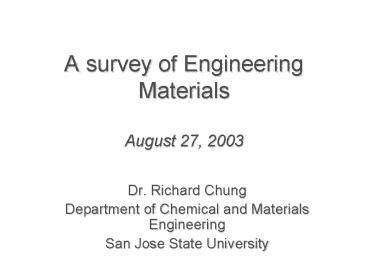A survey of Engineering Materials August 27, 2003 PowerPoint PPT Presentation
1 / 21
Title: A survey of Engineering Materials August 27, 2003
1
A survey of Engineering MaterialsAugust 27, 2003
- Dr. Richard Chung
- Department of Chemical and Materials Engineering
- San Jose State University
2
Types of Engineering Materials
- Metals (alloying elements, processing techniques,
refractory metals, superelastic /superplastic
metals, metallic glass, shape memory alloys,
etc.) - Ceramics (glass, metal oxides, metal carbides,
metal nitrides, etc.) - Polymers (thermoplastics, thermosets, elastomers,
copolymers, plastics alloy, polyblend) - Composites (laminated, braided, pultruded,
nanocompsoites)
3
Definitions
- Plastics alloy refers to two or more different
polymers that are physically mixed during a
melting process. This should not be considered as
copolymer. - Polyblend refers to a polymer that has been
modified by adding an elastomer to it. - No primary bonds are developed between two
dissimilar polymer chains.
4
Factors Affecting Material Performance
- Structure-property-processing relationships
- Hot work, cold work,
- Solid solution strengthening
- Precipitation hardening
- Inclusions
- Imperfections (e.g. number of dislocations)
- Crystal structures Crystalline versus amorphous
- Toughening
- Heat treatment (such as annealing, normalizing,
and quenching) - Residual stresses
5
Things Related to Mechanical Behavior
- Material nature
- Ductile versus brittle fracture
- Static versus cyclic loading
- Deformation mechanisms
- Creep deformation (stress and temperature
effects) - Fatigue fracture (high cycle vs. low cycle)
- Notch sensitivity and loading directions
6
Material Configurations (Composites)
- Ductile - Brittle
- Ductile - Ductile
- Brittle - Brittle
- Brittle - Ductile
- Fiber orientation (reinforcing directions)
- Continuous versus short fiber reinforcement
- Random, intercalation, exfoliation
7
Superplasticity
- Superplasticity is a phenomenon in which some
materials will demonstrate remarkably high strain
to failure at a strain rate roughly around
0.001/s. This phenomenon generally happens at
high temperatures gt 0.5 Tm. - Superplastic deformation can be achieved at high
temperatures to form complex shapes which are
impossible to obtain using traditional processes
such as rolling, forging, extrusion, or drawing
processes.
8
(No Transcript)
9
History of Nanocomposites
- 1993 a versatile synthesis technique developed
- direct mixing of modified clay with melted
polymer - by workers at Cornell University
- stimulated vigorous research (Manius et al.,
2001) - 1999 market analysis performed by Principal
Partners - global market was 2 million pounds (Rossi, 2000)
- predicted to reach 1.2 billion pounds in 2009
10
Structure - Clays
- Clays are a class of minerals consisting of
mainly silica (siO2) and alumina (Al2O3). - Silicate sheets are stacked in sequence using van
der Waal forces or hydrogen bonds. - Typical clays used are montmorillonites,
smectites, and kaolinites. - Montmorillonite structures have an alumina
octahedral sheet sandwiched between two silicate
tetrahedral sheets (21 ratio) - Natural Smectites are missing trivalent aluminum
atoms. Instead, they are replaced by divalent
magnesium, lithium and silicon atoms resulting in
an overall negative charge in structure. - Kaolinites consist of many unit layers sandwiched
together the unit layers are held together by
hydrogen bonds.
11
Introduction to Clays
- Clays are minerals
- Consist of silica (SiO2) and alumina (Al2O3)
- Basic structural component is silicate sheets
with silicon-oxygen 6-membered rings
Figure 1 Silicate Sheet (Si2O5)2- (Callister,
2003)
12
Introduction to Clays
- Smectites are a group of clay minerals with
useful properties for making nanocomposites
Figure 2 Smectite Structure (Worral, 1986)
13
Intercalation and Exfoliation
- Van der Waals gap between Smectite unit layers
- contains H2O and cations such as Na
- gap is naturally hydrophilic
- can be made organophilic by exchanging cations
with organic cation salts - Nanoclays can be purchased from Nanocor and
Southern Clay Products (Cloisite) - Intercalation diffusion of polymer chains into
gaps, resulting in finite expansion (limited
dispersion). Multilayer structure is retained. - Exfoliation extensive polymer penetration,
resulting in delamination and dispersal.
14
Tetrahedral
- Figure 3. Theoretical formula and structure for
montmorillonites - (G-105 Nanocor, technical note)
Octahedral
Tetrahedral
Charged inorganic cation layer (Al3,Ca2, Mg2,
Na, Li, etc.)
15
- Figure 4. Schematic representation of polymer
-layered silicate composite structures
16
Structure of Nanoparticles
- Silica filler or reinforcement
- The chemical name is Polyhedral Oligometric
Silsesquioxanes (POSS) - It will improve Tg, HDT, Creep, compression,
hardness, fire resistance, permeability
17
Types of Polymer Matrixes
- Thermosets polyurethane, phenolic, epoxy,
polyester, vinyl ester - Thermoplastics Nylon, PET, ABS, PI, PP, PC, PEEK
- Elastomers silicone, EPDM
18
Properties
- Mechanical properties tensile, toughness,
hardness, impact, fatigue and creep properties. - Physical properties glass transition temperature
(Tg), permeability, dielectric properties,
optical, thermal and electrical properties. - Chemical properties reactivity, corrosion
resistance, polymerization, biochemical reactions
19
Material Selection
- Process
- Analysis of material application problem
- Translation of the material application
requirements to material property values - Selection of candidate materials
- Evaluation of candidate materials
- Decision making
- Properties
- Mechanical, thermal, chemical, electrical
- Constraints
- Existing facilities
- Compatibility
- Marketability
- Availability
- Disposability and recyclability
20
Selection Procedure for a Cantilever Beam
- Requirements L (length), P (load), X (safety
factor) - Geometry variable r (radius)
- Material properties ? (density), ?o (max.
stress) - Quantity to minimize m
- Q f1 (requirements) f2 (materials)
- ? m f1 (L, P, X) f2 (?, ?o )
21
Summary
- Pure metals in bulk form demonstrate low yield
stresses. Their applications in industry can be
enhanced by introducing various
parameters/obstacles to them such as
dislocations, work hardening, strengthening
effects, heat treatment, etc. - Various materials depending on their geometry and
structural configurations will perform
differently. - Advanced engineering applications such as
superplasticity and nanocompsoites are briefly
discussed to delineate the relationships between
material construction and material performance.

